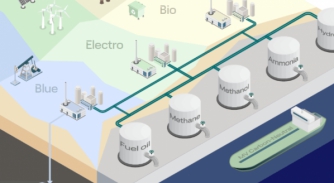Is carbon capture all it’s cracked up to be?
Touted by many as a vital part of the solution to achieving carbon neutrality, is carbon capture a panacea or a technological pipedream? …
Carbon capture, use and storage (CCUS) is often lauded as a silver-bullet solution. This is due to its capability to remove carbon dioxide from the atmosphere, making a positive contribution to achieving net zero. However, the high costs involved, along with the relatively small quantities of carbon captured, raise questions about whether it is the solution we hope it to be.
A key discussion point on this hot topic was made during Day Three at TSF Connect, where Dr Frank Rattey from Planeteers presented some of the innovations in this rapidly evolving field.
So what exactly is it? And where may it be applied to the superyacht industry in the future?
Carbon capture can be employed in two primary ways: either operating directly at the emission source to prevent CO2 from entering the atmosphere or operating to extract carbon from the air and release purified, carbon-free air. In both methods, various options exist for handling the captured carbon.
There are two principal long-term storage methods:
1. Deep geological storage, where CO2 is converted into a high-pressure, liquid-like form and injected directly into sedimentary rocks, where it can remain for millions of years.
2. Mineral storage, where captured CO2 reacts with naturally occurring iron, magnesium and calcium minerals. These minerals are abundant and stable, thus preventing the re-release of CO2 into the atmosphere.
Alternatively, captured carbon can be commercially utilised, such as in carbonated beverages or the production of synthetic fuels. It can also be used to extract remnants of oil and gas from deposits.
Wärtsilä is currently developing a pilot CCUS system to on-board an ethylene carrier, which is set to launch in 2025. The system involves capturing CO2 in a spray tower and saturating an amine-based solvent (amine is a liquid made of an organic nitrogen base). The captured CO2 is then stripped off, compressed and stored. The CCUS pilot unit aims to achieve a carbon capture rate of 70% of CO2 emissions, ensuring compliance with the IMO’s decarbonisation targets. This is an incentive for many to reduce carbon emissions and perform well in both the IMO’s EEXI (Energy Efficiency Existing Ship Index) and CII (Carbon Intensity Indicator).
Any carbon captured but not stored in the long term will be released back into the atmosphere relatively quickly. This will not contribute to carbon reductions over the lifecycle of the stored carbon. Currently, the use of captured carbon in this manner is unregulated, and its economic benefits make it a preferable option to storage. This has led to concerns about how much captured carbon will actually be stored for the long term.
Several issues surround CCUS, primarily because it is still a relatively new technology. Compared to other decarbonisation technologies, like wind and solar power, the costs remain high, and the capacity for capture and storage is limited. Carbon pricing policies must also be stronger to make CCUS economically appealing.
As of 2022, there are 30 operational CCUS projects, with 166 more in the planning or construction phase. The total capture capacity of these 196 projects is approximately 242 million tons per year. The Global CCS Institute has stated that capacity must reach 425–650 million tonnes per year by mid-century, while the International Energy Agency asserts that capacity must reach 1.6 billion tons per year by 2030.
This highlights a substantial gap between current capacity and what is needed to achieve net zero goals. Many argue that the resources and funding allocated to these projects could be better utilised for other decarbonisation technologies and methods to reduce carbon emissions into the atmosphere, such as renewable energy and green hydrogen.
CCUS is often used to offset carbon emissions to achieve carbon neutrality, which can contribute to the misuse of offsetting as a means to continue emitting avoidable carbon. Instead, the focus should be on using carbon-reduction methods like CCUS to offset emissions while actively working to reduce avoidable carbon emissions, with the ultimate goal of only needing to offset the unavoidable carbon emissions from an organisation's activities. This is a common practice in our industry and could also be part of our sustainability efforts unless proper diligence, understanding and scrutiny are in place to prevent this.
The Wärtsilä project offers potential for on-board CCUS, which, with further development, could be implemented in particularly eco-conscious yachts. However, as we currently cannot completely avoid carbon emissions, carbon removal, including CCUS, will remain a part of our arsenal of carbon reduction activities as we strive for a more environmentally friendly future. Therefore, it is crucial for us to reduce the demand for carbon removal in the first place, rather than relying solely on this technology.
Profile links
NEW: Sign up for SuperyachtNewsweek!
Get the latest weekly news, in-depth reports, intelligence, and strategic insights, delivered directly from The Superyacht Group's editors and market analysts.
Stay at the forefront of the superyacht industry with SuperyachtNewsweek
Click here to become part of The Superyacht Group community, and join us in our mission to make this industry accessible to all, and prosperous for the long-term. We are offering access to the superyacht industry’s most comprehensive and longstanding archive of business-critical information, as well as a comprehensive, real-time superyacht fleet database, for just £10 per month, because we are One Industry with One Mission. Sign up here.
Related news

More sustainability jargon busting
Here, we explain more sustainability terms to equip you with an understanding of this fast-paced area
Technology

The missing superyacht sustainability report
Many industries have overarching sustainability reports, providing insights and accountability. Where is the superyacht equivalent performance assessment?
Opinion

Mixed messaging or meaningful change?
Megan Hickling, TSG’s new Sustainability Editor, argues that the superyacht industry should be taking major initiatives that can actually be measured
Opinion

DNV’s energy predictions for the future
The recently released Energy Transition Outlook (ETO) by the Classification Society sheds light on the future energy transition away from fossil fuels
Technology

Sustainability is not always compromise
Sustainability doesn't always have to be solely for the sake of people and the planet
Opinion
Related news
More sustainability jargon busting
2 years ago
The missing superyacht sustainability report
2 years ago
Mixed messaging or meaningful change?
2 years ago
DNV’s energy predictions for the future
2 years ago
Sustainability is not always compromise
2 years ago
NEW: Sign up for
SuperyachtNewsweek!
Get the latest weekly news, in-depth reports, intelligence, and strategic insights, delivered directly from The Superyacht Group's editors and market analysts.
Stay at the forefront of the superyacht industry with SuperyachtNewsweek



